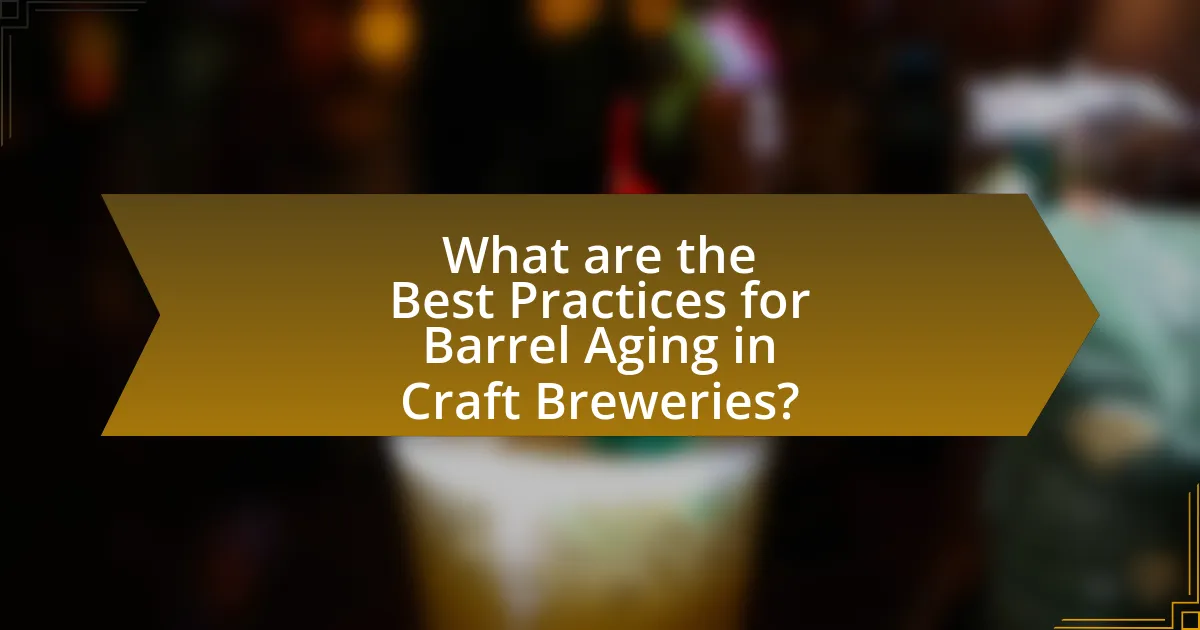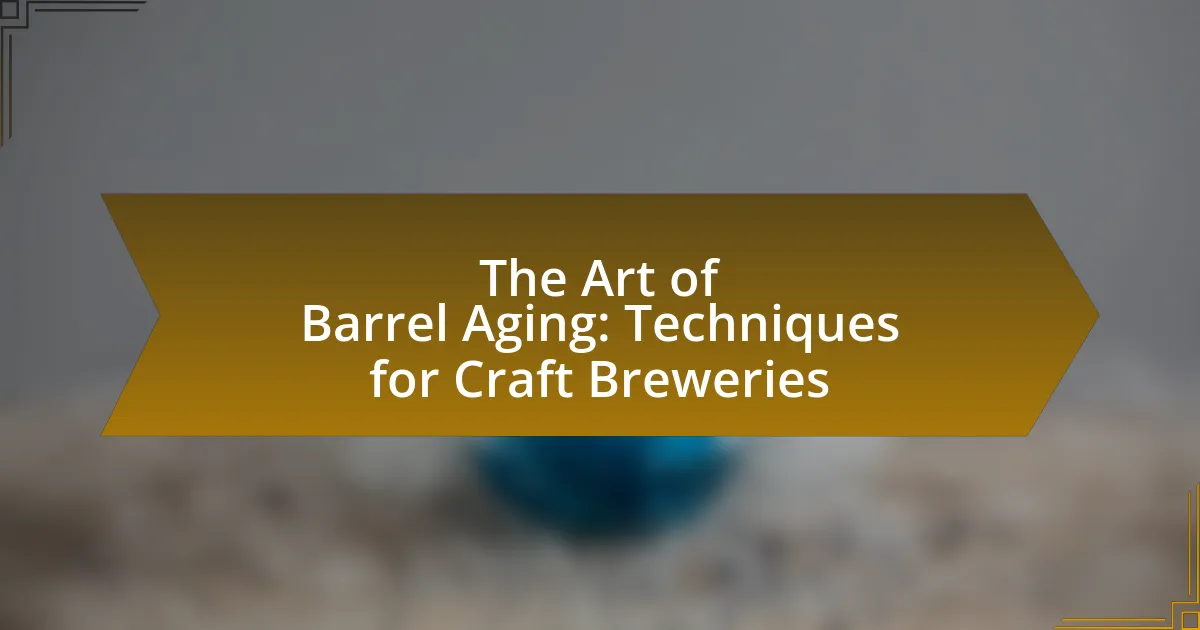Barrel aging is a critical technique in craft brewing that involves maturing beer in wooden barrels, primarily oak, to enhance its flavor and complexity. This process allows the beer to interact with the wood, extracting compounds such as tannins and vanillin, which contribute to the final product’s aroma and taste. The article explores the mechanics of barrel aging, including the types of barrels used, the influence of wood type, and the impact of environmental factors like temperature and humidity. It also addresses best practices for barrel selection, aging duration, and methods to monitor and optimize the aging process, while highlighting common challenges and mistakes to avoid. Overall, the article provides a comprehensive overview of the techniques and considerations essential for successful barrel aging in craft breweries.

What is Barrel Aging in Craft Brewing?
Barrel aging in craft brewing is the process of maturing beer in wooden barrels, which imparts unique flavors and characteristics to the final product. This technique allows the beer to interact with the wood, extracting compounds such as tannins and vanillin, which enhance complexity and depth. Historical practices of barrel aging date back centuries, with many styles, including stouts and sours, benefiting from this method. The use of barrels, often previously used for aging spirits or wine, contributes to the beer’s aroma, taste, and mouthfeel, making it a significant technique in the craft brewing industry.
How does the barrel aging process work?
The barrel aging process involves placing beverages, such as beer or wine, in wooden barrels to enhance their flavor and complexity. During this process, the liquid interacts with the wood, which imparts various compounds, including tannins, vanillin, and lignin, contributing to the beverage’s aroma and taste. Additionally, the porous nature of the wood allows for micro-oxygenation, which can soften flavors and promote maturation. Studies have shown that barrel aging can significantly alter the chemical composition of the beverage, leading to a more rounded and nuanced profile, as evidenced by research published in the Journal of Agricultural and Food Chemistry, which highlights the impact of wood compounds on flavor development.
What types of barrels are commonly used in craft brewing?
Craft breweries commonly use oak barrels, which are favored for their ability to impart complex flavors and aromas to the beer. Oak barrels, particularly those that have previously held wine or spirits, enhance the beer’s profile through the interaction of wood compounds with the liquid. Additionally, other types of barrels, such as stainless steel and bourbon barrels, are also utilized; stainless steel provides a neutral aging environment, while bourbon barrels contribute distinct vanilla and caramel notes due to the charred interior. The use of these barrels is supported by industry practices that highlight their effectiveness in flavor development and aging processes.
How does the wood type influence the aging process?
The wood type significantly influences the aging process by affecting the extraction of compounds and the interaction with the beverage. Different woods, such as oak, cherry, or maple, impart distinct flavors, tannins, and aromas due to their unique chemical compositions and porosities. For instance, oak is commonly used in barrel aging because it contains lactones and vanillin, which contribute to vanilla and coconut notes, enhancing the complexity of the beverage. Additionally, the grain tightness and toast level of the wood can alter the rate of oxygen ingress, impacting oxidation and maturation. Studies have shown that the choice of wood can lead to variations in flavor profiles and aging characteristics, demonstrating the critical role wood type plays in the aging process.
What are the key components of barrel aging?
The key components of barrel aging include the type of wood used, the previous contents of the barrel, the duration of aging, and environmental conditions. The type of wood, such as oak, influences flavor compounds like vanillin and tannins, which enhance the beverage’s complexity. The previous contents, whether whiskey, wine, or other spirits, impart unique characteristics to the aging process, affecting taste and aroma. The duration of aging is critical, as it determines the level of extraction from the wood and the development of flavors; for example, shorter aging may yield fresher notes, while longer aging can produce deeper, more complex profiles. Lastly, environmental conditions, including temperature and humidity, play a significant role in the interaction between the liquid and the barrel, impacting the overall maturation process.
What role does temperature play in barrel aging?
Temperature significantly influences the barrel aging process by affecting the extraction of compounds from the wood and the interaction between the beverage and the barrel. Higher temperatures accelerate the extraction of flavors, tannins, and color from the wood, leading to a more pronounced impact on the final product. Conversely, lower temperatures slow down these processes, resulting in a more subtle integration of flavors. Research indicates that optimal aging temperatures typically range between 55°F to 65°F (13°C to 18°C), as these conditions promote balanced maturation while minimizing undesirable characteristics such as excessive oxidation or spoilage.
How does humidity affect the aging process?
Humidity significantly influences the aging process of beverages in barrels by affecting the rate of evaporation and the interaction between the liquid and the wood. High humidity levels slow down the evaporation of water from the barrel, which can lead to a higher concentration of alcohol and flavors in the beverage. Conversely, low humidity accelerates water loss, potentially resulting in a more pronounced flavor profile due to the increased concentration of compounds. Research indicates that optimal humidity levels, typically between 60% and 80%, are crucial for achieving desired aging characteristics, as they balance the evaporation rates of both water and alcohol, ultimately impacting the final taste and quality of the aged product.
What flavors and characteristics does barrel aging impart?
Barrel aging imparts complex flavors and characteristics such as vanilla, caramel, oak, spice, and sometimes fruit or nut notes. The interaction between the beverage and the wood of the barrel allows for the extraction of compounds like lignin, which contributes to vanilla and caramel flavors, and tannins, which add structure and mouthfeel. Additionally, the aging process can introduce oxidative characteristics, enhancing depth and complexity. Studies have shown that different types of wood and previous contents of the barrel, such as whiskey or wine, significantly influence the final flavor profile, making barrel aging a crucial technique in craft brewing for developing unique and rich beverages.
How do different barrels contribute to flavor profiles?
Different barrels contribute to flavor profiles by imparting unique characteristics based on their wood type, previous contents, and toasting or charring processes. For example, American oak barrels typically add vanilla, caramel, and coconut notes due to their high lactone content, while European oak barrels often enhance flavors of spice, dried fruit, and nuttiness because of their tighter grain and different chemical composition. Additionally, barrels that previously held spirits, such as bourbon or rum, can infuse residual flavors from those liquids, further diversifying the flavor profile of the aged product. Studies have shown that the interaction between the wood and the liquid during aging can lead to significant changes in flavor, aroma, and mouthfeel, making barrel selection a critical aspect of the aging process in craft breweries.
What are the common flavor notes associated with barrel-aged beers?
Common flavor notes associated with barrel-aged beers include vanilla, oak, caramel, and various spices. These flavors arise from the interaction between the beer and the wood of the barrel, which imparts compounds such as vanillin and tannins. Additionally, barrel aging can introduce notes of chocolate, coffee, and dried fruit, depending on the type of barrel used, such as bourbon or wine barrels. The aging process typically enhances the complexity and depth of the beer, resulting in a rich flavor profile that is highly sought after in craft brewing.

What Techniques are Used in Barrel Aging?
Barrel aging employs several techniques to enhance the flavor and character of beverages. These techniques include toasting and charring the interior of the barrels, which caramelizes the wood sugars and adds complexity to the final product. Additionally, the use of different types of wood, such as American oak or French oak, influences the flavor profile due to the distinct compounds present in each wood type. The duration of aging also plays a critical role; longer aging periods can lead to more pronounced flavors and aromas as the beverage interacts with the wood. Furthermore, the temperature and humidity conditions during aging can affect the extraction of flavors and the overall maturation process. These techniques are widely recognized in the craft brewing industry for their ability to create unique and high-quality products.
How do breweries select barrels for aging?
Breweries select barrels for aging based on several key factors, including the type of wood, previous contents, and the desired flavor profile. The choice of wood, such as oak, influences the beer’s tannins and aromatic compounds, while barrels previously used for spirits or wine impart unique characteristics. For instance, bourbon barrels can add vanilla and caramel notes, while wine barrels may contribute fruity or earthy flavors. Breweries often evaluate the barrel’s condition and history to ensure it will enhance the aging process, as well-maintained barrels can provide optimal results. This selection process is critical for achieving the intended complexity and depth in the final product.
What factors influence barrel selection?
Barrel selection is influenced by several key factors, including the type of wood, previous contents, and desired flavor profile. The type of wood, such as American oak or French oak, affects the extraction of compounds that contribute to flavor and aroma. Previous contents, like bourbon or wine, impart unique characteristics to the barrel, impacting the final product’s taste. Additionally, the desired flavor profile, which varies based on the specific beer style, guides brewers in choosing barrels that will enhance or complement the beer’s inherent qualities. These factors collectively determine the suitability of a barrel for aging specific craft beers.
How does the previous use of a barrel affect its suitability for aging?
The previous use of a barrel significantly affects its suitability for aging by influencing the flavor profile and chemical composition imparted to the aging beverage. Barrels previously used for aging spirits, such as whiskey or rum, can impart complex flavors like vanilla, caramel, and spice, enhancing the final product. Conversely, barrels that have been used for aging wine may contribute different characteristics, such as fruitiness or tannins. The residual compounds left in the wood from prior contents can interact with the aging beverage, altering its taste and aroma. Research indicates that the type of wood and its previous contents can lead to distinct aging outcomes, as seen in studies examining the impact of barrel history on wine and beer flavor development.
What methods are employed during the aging process?
The methods employed during the aging process in barrel aging include temperature control, humidity management, and the selection of specific wood types. Temperature control is crucial as it affects the extraction of flavors and compounds from the wood, with optimal aging typically occurring between 55°F and 65°F. Humidity management helps prevent excessive evaporation of the liquid, known as the “angel’s share,” which can impact the final product’s concentration and flavor profile. Additionally, the choice of wood, such as American oak or French oak, influences the flavor characteristics imparted to the beverage, as different woods contain varying levels of compounds like vanillin and tannins that enhance the aging process.
How do breweries monitor the aging process?
Breweries monitor the aging process primarily through sensory evaluation, chemical analysis, and temperature control. Sensory evaluation involves tasting and smelling the beer at various stages to assess flavor development and aroma changes. Chemical analysis includes measuring parameters such as pH, alcohol content, and volatile compounds to track the beer’s chemical evolution. Additionally, maintaining optimal temperature conditions is crucial, as fluctuations can affect the aging process and the final product’s quality. These methods ensure that breweries can produce consistent and high-quality aged beers.
What techniques are used to blend barrel-aged beers?
Blending barrel-aged beers involves several techniques, including sensory evaluation, component selection, and iterative blending. Sensory evaluation allows brewers to assess the aroma, flavor, and mouthfeel of individual barrel-aged beers, identifying which components will complement each other. Component selection involves choosing specific barrels based on their characteristics, such as age, type of wood, and previous contents, to achieve a desired flavor profile. Iterative blending is the process of mixing small batches and tasting them repeatedly to refine the blend until the desired balance is achieved. These techniques ensure that the final product showcases complexity and harmony, reflecting the unique qualities of each barrel used.
What are the challenges faced during barrel aging?
Barrel aging presents several challenges, including temperature fluctuations, oxidation, and contamination. Temperature fluctuations can lead to inconsistent aging processes, affecting the flavor profile of the beverage. Oxidation occurs when oxygen interacts with the liquid, potentially resulting in undesirable flavors if not managed properly. Contamination from bacteria or wild yeast can spoil the product, necessitating strict sanitation practices. These challenges require careful monitoring and management to ensure the quality of the final product.
How can oxidation be managed in barrel aging?
Oxidation in barrel aging can be managed by controlling oxygen exposure through careful monitoring of barrel integrity and utilizing techniques such as topping off barrels and using inert gases. Maintaining barrel integrity prevents excessive oxygen ingress, which can lead to undesirable oxidation flavors. Topping off barrels minimizes headspace, reducing the amount of oxygen available for oxidation reactions. Additionally, the use of inert gases like nitrogen or argon can displace oxygen in the barrel, further limiting oxidation. These methods are supported by research indicating that controlled oxygen exposure can enhance flavor complexity while preventing spoilage.
What are the risks of contamination in barrel aging?
The risks of contamination in barrel aging include microbial spoilage, oxidation, and off-flavors. Microbial spoilage can occur from bacteria and wild yeast, which may thrive in the barrel environment, leading to undesirable flavors and aromas. Oxidation can happen if barrels are not properly sealed, resulting in a loss of freshness and the development of stale or cardboard-like flavors. Off-flavors can also arise from residual compounds in previously used barrels, which may impart unwanted characteristics to the aged product. These risks highlight the importance of proper sanitation, monitoring, and barrel selection in the barrel aging process.

What are the Best Practices for Barrel Aging in Craft Breweries?
The best practices for barrel aging in craft breweries include selecting high-quality barrels, maintaining proper sanitation, monitoring temperature and humidity, and conducting regular tastings. High-quality barrels, often sourced from reputable wineries or distilleries, impart desirable flavors and characteristics to the beer. Sanitation is crucial to prevent contamination; thorough cleaning and sanitizing of barrels before use ensures a healthy aging environment. Monitoring temperature and humidity levels helps maintain consistency and prevents spoilage, as fluctuations can adversely affect the aging process. Regular tastings allow brewers to assess the beer’s development and make necessary adjustments, ensuring the final product meets quality standards. These practices are supported by industry standards and expert recommendations, emphasizing their importance in achieving optimal results in barrel aging.
How can breweries optimize their barrel aging process?
Breweries can optimize their barrel aging process by carefully selecting the type of wood, controlling temperature and humidity, and monitoring the aging duration. The choice of wood, such as American oak or French oak, significantly influences flavor compounds, with American oak imparting vanilla and coconut notes, while French oak adds spice and tannins. Maintaining a stable temperature between 50-65°F and humidity levels around 70% prevents excessive evaporation and ensures consistent aging. Additionally, regular sampling during the aging process allows brewers to assess flavor development and determine the optimal aging time, which can vary from a few months to several years depending on the desired profile. These practices enhance the quality and complexity of the final product, leading to a more refined barrel-aged beer.
What are the recommended aging times for different beer styles?
The recommended aging times for different beer styles vary significantly. Generally, lighter beers such as lagers and wheat beers are best consumed fresh, ideally within a few weeks to a few months after brewing. In contrast, IPAs can be aged for about 1 to 3 months, although they are also best enjoyed fresh to preserve hop flavors.
Stronger ales, such as Belgian styles and barleywines, benefit from longer aging, typically ranging from 6 months to several years, allowing complex flavors to develop. Stouts and porters can also age well, with recommended times of 6 months to 2 years, depending on the specific style and ingredients used.
Sour beers, including lambics and Berliner weisse, often require extended aging, sometimes up to several years, to achieve their characteristic tartness and depth. These aging recommendations are based on brewing practices and flavor development observed in various beer styles.
How should barrels be maintained and stored for optimal aging?
Barrels should be maintained and stored in a controlled environment with consistent temperature and humidity levels for optimal aging. Maintaining a temperature range of 55-65°F and humidity levels around 70-80% prevents excessive evaporation and ensures proper wood interaction. Regularly inspecting barrels for leaks and cleaning them with hot water or steam helps preserve their integrity and prevents contamination. Additionally, rotating barrels periodically allows for even aging and flavor development. Research indicates that these practices enhance the quality of the final product by promoting desirable chemical reactions within the barrel.
What common mistakes should be avoided in barrel aging?
Common mistakes to avoid in barrel aging include improper sanitation, inadequate monitoring of temperature and humidity, and neglecting to taste regularly. Sanitation is crucial because any contaminants can spoil the product; for instance, bacteria can thrive in poorly cleaned barrels, leading to off-flavors. Monitoring temperature and humidity is essential as fluctuations can affect the aging process and flavor development; optimal conditions typically range from 60°F to 70°F with humidity levels around 70%. Regular tasting allows brewers to assess the aging process and make necessary adjustments; failing to do so can result in over-aging or undesirable flavors.
How can over-aging affect the final product?
Over-aging can negatively impact the final product by leading to undesirable flavors and aromas. When a product, such as beer or whiskey, is aged beyond its optimal period, it can develop excessive woodiness, tannins, or astringency, which can overpower the intended flavor profile. Research indicates that certain compounds, like vanillin and lignin, can become overly pronounced with extended aging, resulting in an imbalance that detracts from the overall quality. For instance, a study published in the Journal of Agricultural and Food Chemistry found that prolonged barrel aging can significantly alter the sensory characteristics of spirits, emphasizing the importance of timing in the aging process.
What are the signs of a poorly aged beer?
Signs of a poorly aged beer include off-flavors, excessive oxidation, and undesirable aromas. Off-flavors can manifest as cardboard or sherry-like notes, indicating that the beer has been exposed to too much oxygen. Excessive oxidation often leads to a dull or flat taste, diminishing the beer’s original character. Additionally, undesirable aromas such as vinegar or sourness can suggest spoilage or contamination. These indicators are critical for brewers to assess the quality of barrel-aged beers, as they directly impact the overall drinking experience.
What tips can enhance the barrel aging experience?
To enhance the barrel aging experience, brewers should carefully select the type of barrel based on the desired flavor profile, as different woods and previous contents impart unique characteristics. For example, using bourbon barrels can add vanilla and caramel notes, while wine barrels may contribute fruity and tannic qualities. Additionally, monitoring the aging environment, including temperature and humidity, is crucial, as these factors influence the extraction of flavors from the wood. Regularly sampling the beer during the aging process allows brewers to determine the optimal aging time, ensuring the final product achieves the intended taste. Lastly, blending different barrels can create complex flavors, as combining various profiles can enhance the overall depth of the beer.
How can experimentation with barrel aging lead to unique flavors?
Experimentation with barrel aging can lead to unique flavors by allowing the interaction between the beverage and the wood, which imparts various compounds into the liquid. Different types of barrels, such as those previously used for bourbon, wine, or rum, contribute distinct flavor profiles due to their unique wood characteristics and residual compounds. For instance, bourbon barrels often add notes of vanilla and caramel, while wine barrels can introduce fruity or tannic elements. Additionally, the length of aging and environmental factors, such as temperature and humidity, further influence the extraction of flavors from the wood. Research indicates that the chemical compounds released during aging, such as lignin and hemicellulose breakdown products, play a significant role in flavor development, enhancing complexity and depth in the final product.
What resources are available for breweries looking to improve their barrel aging techniques?
Breweries looking to improve their barrel aging techniques can access a variety of resources, including industry workshops, online courses, and specialized literature. Workshops, such as those offered by the Brewers Association, provide hands-on training and expert insights into barrel management and flavor development. Online courses from platforms like CraftBeer.com cover essential topics related to barrel aging, including wood selection and microbial management. Additionally, books like “Barrel-Aged Stout and Selling Out” by Tony Magee offer in-depth knowledge and practical advice on the intricacies of barrel aging. These resources collectively enhance a brewery’s understanding and execution of barrel aging techniques, leading to improved product quality.
